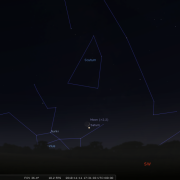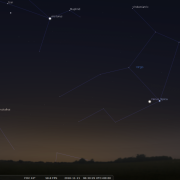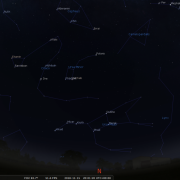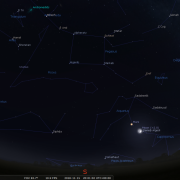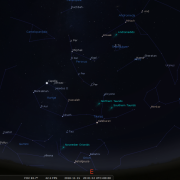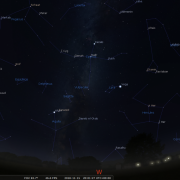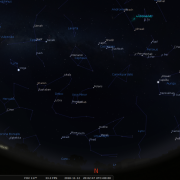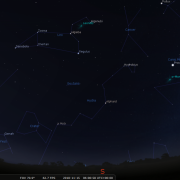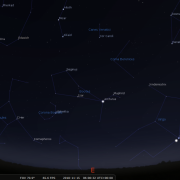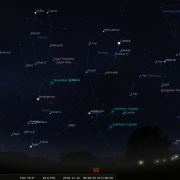
Welcome to the WDAS monthly newsletter for November 2018: a digest of the month's latest contributions to our website.
Below you'll find Society News, Sky Notes; details of our past and future events, including the WDAS Christmas Dinner Menu!
Society News
After a mild week of clear evenings, it was on the cards that for the weekend of the half term ‘dark sky’ event at the Danby Moors Centre, an arctic plunge would complicate matters. Chilly, blustery, showery conditions are not conducive for observing outdoors. Therefore the decision was taken to host an indoor presentation for the 55 or so people who had booked to come along. Although conditions did improve marginally, it proved to be the correct choice.
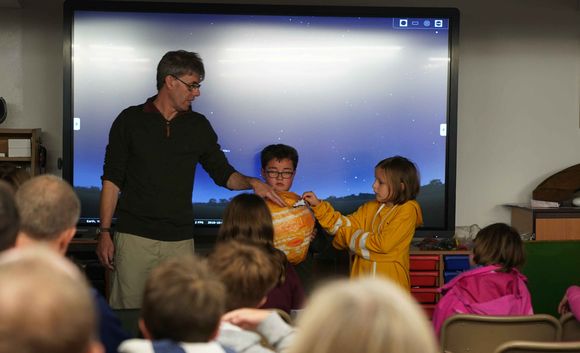
Mark, Barbara, Andy, Elaine and Keith all met at Mark’s house to divvy up the equipment (a couple of scopes were taken – just in case) before setting off in Convoy to Danby. Welcomed on arrival by Karen, Rita and the centre staff, everything was unloaded and transported up to lecture room with all our poster boards displayed around the walls. The centre has an interactive touch screen on which Stellarium was running, which proved useful as we couldn’t hook up the laptop to use the starry night program (not the right kind of connections)
By 18:30h the room was full, and having made apologies about the weather, the obligatory H&S and Fire announcements, Mark started.
Using some new scaled demo’s utilising the inflatable solar system planets, together with other aids – including a model space shuttle, the Earth-moon size and distance scale was demonstrated with enthusiastic help from the children in the audience.
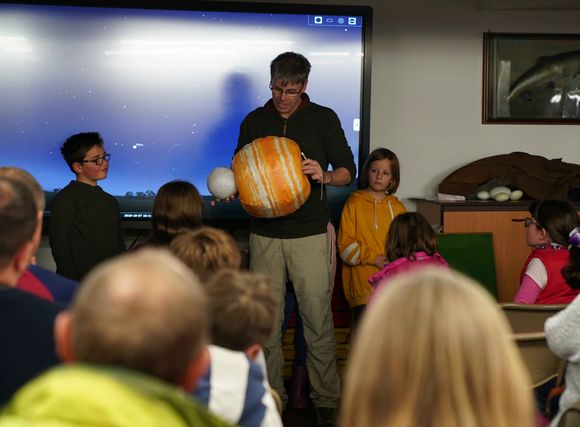
A ball of suitably marked string was then ‘unwound’ – again with lots of help, to demonstrate our normal scale solar system, and caused much hilarity as it became apparent, that beyond Saturn (which was located in the ‘tree’ part of solar system –who knew?) that several walls would have to demolished to reach Uranus and Neptune! Mark further went on to demonstrate the scale of the galaxy and universe using nothing but reams of paper.
After a break, the Stellarium program was employed, really quite wonderful using the large interactive touch screen, that is until glitches continually caused it to shut down, so Andy had manipulate the Stellarium controls on the computer screen, whilst Mark tried to avoid touching the screen. It seemed to do the trick. A further short power point presentation of the various types of deep sky objects located around the autumn sky, some of which were then highlighted by using the Stellarium planetarium, rounded of proceedings.
It wasn’t the event we had hoped to host – ie. outdoors with telescopes, but it was nevertheless much appreciated by the audience and hopefully the event at the Moors Centre in early March will have better conditions. Thanks to all for their time and assistance.
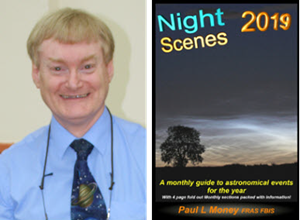 We will be putting in an order for 25 copies of Night Scenes 2019, however they are not expected out until late October/early November, so we may have to be a little patient. The price may also have increased, though perhaps not to the stated price on the Astrospace website, (Paul normally does us a deal).
We will be putting in an order for 25 copies of Night Scenes 2019, however they are not expected out until late October/early November, so we may have to be a little patient. The price may also have increased, though perhaps not to the stated price on the Astrospace website, (Paul normally does us a deal).
If you want to reserve a copy please let Mark know. We don’t have to remind you how indispensable Paul’s colour almanac for the astronomical year ahead is, there is nothing better out there for any astronomer or casual stargazer; a great Christmas gift.
Here's a link to Paul's website, if you want to look at Paul’s website.
Latest – Paul has received our order and hopefully we shall have the 25 copies by the November meeting.
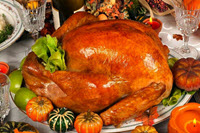 We have now booked the Hare and Hounds for Dec 1st for 19:00h. The booking is for up to 15 people, give or take, so it will be first come first serve. A pre order of menu choices will be required a week before the date.
We have now booked the Hare and Hounds for Dec 1st for 19:00h. The booking is for up to 15 people, give or take, so it will be first come first serve. A pre order of menu choices will be required a week before the date.
No deposit is required from the Hare and Hounds at this stage. The Christmas fayre is excellent and the evening most enjoyable. We shall be taking names, rank and serial numbers at the November society meeting on the 6th. Failing that, please contact Mark Dawson.
WDAS Christmas Menu at the Hare & Hounds, Hawsker
Starters
- Lightly spiced butternut squash soup with crusty bread
- Atlantic prawn and smoked salmon cocktail, with Marie Rose sauce & crusty bread
- Duck & chicken pressed terrine, orange marmalade & crusty bread
- Tandoori style pigeon, with hounds own naan bread & mango dip
- Button mushrooms in a smoked applewood cheddary & spinach sauce, with crusty bread
Main Course
- The Hounds' own turkey ballantine, stuffed with sausage meat & chestnuts, wrapped in parma ham, served with creamed potatoes, roasted new potatoes, cranberry jelly & seasonal vegetables
- Shin of beef, served with herbed dumplings, truffled mashed potatoes, game chips & seasonal greens
- Camembert and cranberry pitbivier with rosemary potatoes
- Apple, sage & prosciutto stuffed pork loin, with roast garlic creamed potatoes, cider reduction and seasonal greens
- Chicken breast, stuffed with spinach & ricotta cheese, wrapped in streaky bacon with dauphinoise potatoes & white wine sauce
- Grilled hake on a bed of pea & king prawn risotto with crispy fennel
Desserts
- Traditional Christmas Pudding with Courvoisier custard
- The Hounds' black forest cheesecake
- Clementine creme brûlée with a chocolate shortbread biscuit
- Sticky toffee & date pudding with homemade vanilla ice cream
- Cheese platter, with a selection of biscuits & fig chutney.
Cost: £24.95 per person.
Sky Notes
In this month's Sky Notes:
Planetary Skylights
Evening
 Jupiter finally departs the evening sky during late November, but is so low and above the SW horizon for less than 30mins it’s hardly worth bothering with.
Jupiter finally departs the evening sky during late November, but is so low and above the SW horizon for less than 30mins it’s hardly worth bothering with.

 Saturn is now slipping down toward the SW horizon and by the month’s end will only be visible for around half an hour after sunset, so make the most of any observing opportunities during early November. View on the 11th when Saturn is in a close and pleasing conjunction with The Crescent Moon. Telescopically, the image of Saturn will gradually deteriorate as it drops into ever more turbulent air near the horizon, but have patience and clearer glimpses of the rings will resolve. A speck of light nearby is Saturn’s major moon, Titan.
Saturn is now slipping down toward the SW horizon and by the month’s end will only be visible for around half an hour after sunset, so make the most of any observing opportunities during early November. View on the 11th when Saturn is in a close and pleasing conjunction with The Crescent Moon. Telescopically, the image of Saturn will gradually deteriorate as it drops into ever more turbulent air near the horizon, but have patience and clearer glimpses of the rings will resolve. A speck of light nearby is Saturn’s major moon, Titan.
 The unmistakable and conspicuous orange hue of Mars rides low in the south as twilight falls. During November Mars rapidly moves through the tail end of Capricornus and up into Aquarius, keeping ahead of the brighter twilight and moving higher into the sky than it has so far been this year. Telescopically the Martian disk will however appear only half the size it did at opposition in July as the distance between our two worlds grows ever greater. That said ‘seeing’ will be a little more stable and surface detail (darker areas and the polar caps) will be apparent through the eyepiece of modest or larger scopes. View on the 15th and 16th when The Moon lies nearby.
The unmistakable and conspicuous orange hue of Mars rides low in the south as twilight falls. During November Mars rapidly moves through the tail end of Capricornus and up into Aquarius, keeping ahead of the brighter twilight and moving higher into the sky than it has so far been this year. Telescopically the Martian disk will however appear only half the size it did at opposition in July as the distance between our two worlds grows ever greater. That said ‘seeing’ will be a little more stable and surface detail (darker areas and the polar caps) will be apparent through the eyepiece of modest or larger scopes. View on the 15th and 16th when The Moon lies nearby.
 Having not long reached opposition, Uranus, at magnitude +5.65 is readily visible in binoculars; however, to discern its small disk, which is grey/green in hue, a telescope will be needed. During mid evening Uranus is located across in the south east approximately two degrees to the left of the star Omicron Piscis; Torcularis Septentrionalis, although Uranus actually lies in the extreme lower right corner of Aries. The stars Sheratan and Mesarthim point down to Omicron piscis. The Gibbous Moon lies around five degrees below Uranus on the 20th.
Having not long reached opposition, Uranus, at magnitude +5.65 is readily visible in binoculars; however, to discern its small disk, which is grey/green in hue, a telescope will be needed. During mid evening Uranus is located across in the south east approximately two degrees to the left of the star Omicron Piscis; Torcularis Septentrionalis, although Uranus actually lies in the extreme lower right corner of Aries. The stars Sheratan and Mesarthim point down to Omicron piscis. The Gibbous Moon lies around five degrees below Uranus on the 20th.
 Neptune is located in the SSW within the constellation of Aquarius, approximately a binocular field lower left of the asterism known as the ‘water jar’ and the a few degrees to the left of Lamda Aquarii. You will require a telescope to identify it, appearing as a tiny blue/grey disk. Look for it just below-left of 81 Aqr. The Moon resides in line and around 4 degrees to the left of Neptune on the 17th Next month Mars and Neptune will have a splendid conjunction, a great opportunity to track down the outermost major planet.
Neptune is located in the SSW within the constellation of Aquarius, approximately a binocular field lower left of the asterism known as the ‘water jar’ and the a few degrees to the left of Lamda Aquarii. You will require a telescope to identify it, appearing as a tiny blue/grey disk. Look for it just below-left of 81 Aqr. The Moon resides in line and around 4 degrees to the left of Neptune on the 17th Next month Mars and Neptune will have a splendid conjunction, a great opportunity to track down the outermost major planet.
Morning
 Venus makes a dazzling return into the dawn sky and will be visible low in the SE aspect. If you view around 06:30h throughout the month, notice how Venus glides up to the bright star Spica in Virgo, reaching it by the 16th, before turning to the east and moving away. A very slim waning Moon lies off to the upper left on the 6th.
Venus makes a dazzling return into the dawn sky and will be visible low in the SE aspect. If you view around 06:30h throughout the month, notice how Venus glides up to the bright star Spica in Virgo, reaching it by the 16th, before turning to the east and moving away. A very slim waning Moon lies off to the upper left on the 6th.
Meteors

The Leonids are active from Nov 15-20th with the 2018 peak expected to last over the 17th and 18th. A waxing moon will be visible during the evening, so perhaps wait until after it has set, making post midnight, or the early morning hours of the 17th and 18th the optimum time to observe (the best time anyway)
Leonids are associated with the periodic comet Temple Tuttle, which has an orbital period of 33yrs. The orbit intersects Earth’s and over thousands of years the debris stream deposited by each pass of the comet has been swept into complex strands. At roughly 33yr intervals, Earth ploughs through the latest dense strand of material giving rise to ‘storm’ levels of meteor activity. The last ones occurred in 1998 and 1999, when from far Asia peak rates were estimated to be in the low thousands per hour. This year, however is again a normal peak rate one, so expect early morning levels of around 10-15 per hour. The next Leonid ‘storm’ is not due until 2030.
Also during November keep an eye out for a few meteors on the night of Nov 4/5th when the South Taurid meteor shower reaches a peak, and then again on the night of Nov 11/12 when the North Taurid meteor shower peaks. The hourly rate is low; - only around 5 meteors, but although few, Taurids can be very bright with occasional fireballs! The Taurids are an old shower, associated with the periodic Comet Enke. Over time dust from this comet has been depleted and spread out over a broad swath of the inner solar system, giving rise to Taurid meteor showers not only on Earth but also on Mars and Venus too!
Comets
Comet 46P/Wirtanen continues to gradually ‘brighten’ although as yet is not well placed for UK observers. This is a short-period comet who’s orbit takes 5.4 years and is rather small being just over 1km in diameter. 46P/Wirtanen was actually the original target for ESA’s Rosetta spacecraft, but the launch window was missed so 67P/Churymov-Gerasimenko was chosen instead.
Comet 46P/Wirtanen is expected to become a naked eye object by early/mid December, perhaps reaching magnitude +4.5 around perihelion passage on 16 December when it will pass 0.078 AU (7,220,000miles) from Earth. At this point comet 46P will be Taurus, quite near the Pleiades star cluster. Currently at mag + (to update) during late November the 46P resides in Cetus before moving into Eridarnus. Comet update next month.
November 2018 Sky Charts
|
Looking North
Mid-November - 20:00h |
Looking South |
|
Looking East
Mid-November - 20:00h |
Looking West
Mid-November - 20:00h |
|
Northern Aspect
12-Oct-2018 at 20:00h |
Southern Aspect
12-Oct-2018 at 20:00h |
| Looking North (Early) Mid-November - 06:00h |
Looking South (Early) Mid-November - 06:00h |
| Looking East (Early) Mid-November - 06:00h |
Looking West (Early) Mid-November - 06:00h |
Additional Image Credits:
- Planets and Comets where not otherwise mentioned: NASA
- Sky Charts: Stellarium Software
Events
 Observe the night sky with us at the Bruce Observatory, Whitby School
Observe the night sky with us at the Bruce Observatory, Whitby School
Observing Nights are held weather permitting: check for a relatively clear sky before leaving home. If in doubt, Mark can be reached on 07886069339
Please note the college drive gate is now operated via a electronic key code - so anyone wishing to attend must be at the car park at the top of the drive by 19:00hrs - unless an arrival time has been arranged with Mark/Keith.
 Observe the night sky with us at the Bruce Observatory, Whitby School
Observe the night sky with us at the Bruce Observatory, Whitby School
Observing Nights are held weather permitting: check for a relatively clear sky before leaving home. If in doubt, Mark can be reached on 07886069339
Please note the college drive gate is now operated via a electronic key code - so anyone wishing to attend must be at the car park at the top of the drive by 19:00hrs - unless an arrival time has been arranged with Mark/Keith.
 Whitby School - Room H1.
Whitby School - Room H1.
In Members' monthly meetings we usually take a tour of the night sky for the coming month using the Planetarium program. Have talks and presentations on various topics of astronomy/space etc, and discuss future events etc. New members welcome.
 Observe the night sky with us at the Bruce Observatory, Whitby School
Observe the night sky with us at the Bruce Observatory, Whitby School
Observing Nights are held weather permitting: check for a relatively clear sky before leaving home. If in doubt, Mark can be reached on 07886069339
Please note the college drive gate is now operated via a electronic key code - so anyone wishing to attend must be at the car park at the top of the drive by 19:00hrs - unless an arrival time has been arranged with Mark/Keith.
 Observe the night sky with us at the Bruce Observatory, Whitby School
Observe the night sky with us at the Bruce Observatory, Whitby School
Observing Nights are held weather permitting: check for a relatively clear sky before leaving home. If in doubt, Mark can be reached on 07886069339
Please note the college drive gate is now operated via a electronic key code - so anyone wishing to attend must be at the car park at the top of the drive by 19:00hrs - unless an arrival time has been arranged with Mark/Keith.

